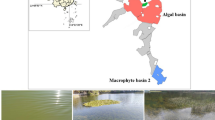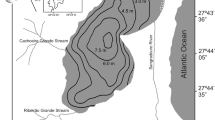Abstract
In saline lakes, areal cover and both species and structural diversity of macrophytes often decline as salinity increases. To assess effects of the loss of certain macrophyte growth forms, we characterized benthic and epiphytic invertebrates in three growth forms (thin-stemmed emergents, erect aquatics, and low macroalgae) in oligosaline lakes (0.8–4.2 mS cm−1) of the Wyoming High Plains, USA. We also measured the biomass and taxonomic composition of epiphytic and benthic invertebrates in two erect aquatics with very similar structure that are found in both oligosaline (Potamogeton pectinatus) and mesosaline (9.3–23.5 mS cm−1) (Ruppia maritima) lakes. Although total biomass of epiphytic invertebrates varied among oligosaline lakes, the relative distribution of biomass among growth forms was similar. For epiphytic invertebrates, biomass per unit area of lake was lowest in emergents and equivalent in erect aquatics and low macroalgae; biomass per unit volume of macrophyte habitat was greatest in low macroalgae. For benthic invertebrates, biomass was less beneath low macroalgae than other growth forms. Taxonomic composition did not differ appreciably between growth forms for either benthic or epiphytic invertebrates, except that epiphytic gastropods were more abundant in erect aquatics. Total biomass of epiphytic and benthic invertebrates for the same growth form (erect aquatic) did not differ between oligosaline (Potamogeton pectinatus) and mesosaline (Ruppia maritima) lakes, but taxonomic composition did change. In the oligosaline to mesosaline range, direct toxic effects of salinity appeared important for some major taxa such as gastropods and amphipods. However, indirect effects of salinity, such as loss of macrophyte cover and typically higher nutrient levels at greater salinities, probably have larger impacts on total invertebrate biomass lake-wide.
Similar content being viewed by others
References
Allanson, B. R., 1973. The fine structure of the periphyton ofChara sp. andPotamogeton natans from Wytham Pond, Oxford, and its significance to the macrophyte-periphyton metabolic model of R. G. Wetzel and H. L. Allen. Freshwat. Biol. 3: 535–542.
Bierhuizen, J. F. H & E. E. Prepas, 1985. Relationships between nutrients, dominant ions, and phytoplankton standing crop in prairie saline lakes. Can J. Fish aquat. Sci 42: 1588–1594.
Caraco, N. F., J. J. Cole & G. E. Likens, 1989. Evidence for sulphate-controlled phosphorus release from sediments of aquatic systems. Science 341: 316–318.
Chambers, P. A., 1987. Light and nutrients in the control of aquatic plant community structure II.In situ observations. J. Ecol. 75: 621–628.
Chilton, E. W., 1990. Macroinvertebrate communities associated with three aquatic macrophytes (Ceratophyllum demersum, Myriophyllum spicatum, andVallisneria americana) in Lake Onalaska, Wisconsin. J. Freshwat. Ecol. 5: 455–466.
Clavero, V., J. A. Fernandez & F. X. Niell, 1990. Influence of salinity on the concentration and rate of interchange of dissolved phosphate between water and sediment in Fuente Piedra lagoon (S. Spain). Hydrobiologia 197: 91–97.
Cowardin, L. M., V. Carter, F. C. Golet & E. T. LaRoe, 1979. Classification of wetlands and deepwater habitats of the United States. U.S. Fish and Wildl. Serv., FWS/OBS-79/31, Washington, D.C.
Crumpton, W. G., 1989. Algae in northern prairie wetlands. In A. van der Valk (ed.) Northern prairie wetlands. Iowa State University Press, Ames: 188–203.
Cyr, H. & J. A. Downing, 1988a. The abundance of phytophilous invertebrates on different species of submerged macrophytes. Freshwat. Biol. 20: 365–374.
Cyr, H. & J. A. Downing, 1988b. Empirical relationships of phytomacrofaunal abundance to plant biomass and macrophyte bed characteristics. Can. J. Fish. aquat. Sci. 45: 976–984.
Duarte, C. M. & J. Kalff, 1990. Biomass density and the relationship between submerged macrophyte biomass and plant growth form. Hydrobiologia 196: 17–23.
Dvorak, J. & E. P. H. Best, 1982. Macro-invertebrate communities associated with the macrophytes of Lake Vechten: structural and functional relationships. Hydrobiologia 95: 115–126.
Galat, D. L., M. Coleman & R. Robinson, 1988. Experimental effects of elevated salinity on three benthic invertebrates in Pyramid Lake, Nevada. Hydrobiologia 158: 133–144.
Gilinsky, E., 1984. The role of fish predation and spatial heterogeneity in determining benthic community structure. Ecology 65: 455–468.
Gregg, W. W. & F. L. Rose, 1985. Influences of aquatic macrophytes on invertebrate community structure, guild structure, and microdistribution in streams. Hydrobiologia 128: 45–56.
Hammer, U. T., 1981. Primary production in saline lakes. Hydrobiologia 81: 47–57.
Hammer, U. T. & J. M. Heseltine, 1988. Aquatic macrophytes in saline lakes of the Canadian prairies. Hydrobiologia 158: 101–116.
Hammer, U. T., J. S. Sheard & J. Kranabetter, 1990. Distribution and abundance of littoral benthic fauna in Canadian prairie saline lakes. Hydrobiologia 197: 173–192.
Hanson, J. M., 1990. Macroinvertebrate size-distributions of two contrasting freshwater macrophyte communities. Freshwat. Biol. 24: 481–491.
Hargeby, A., 1990. Macrophyte associated invertebrates and the effect of habitat permanence. Oikos 57: 338–346.
Hillebrand, H., 1983. Development and dynamics of floating clusters of filamentous algae. In R. G. Wetzel (ed.), Periphyton of freshwater systems. Dr W. Junk Publishers, The Hague: 31–39.
Kantrud, H. A., J. B. Millar & A. G. van der Valk, 1989. Vegetation of wetlands of the prairie pothole region. In A. G. van der Valk (ed.), Northern prairie wetlands. Iowa State University Press, Ames: 132–187.
Kornijow, R., 1992. Seasonal migration by larvae of an epiphytic chironomid. Freshwat. Biol. 27: 85–89.
Kornijow, R., R. D. Gulati & E. van Donk, 1990. Hydrophyte-macroinvertebrate interactions in Zwemlust, a lake undergoing biomanipulation. Hydrobiologia 200/201 (Dev. Hydrobiol. 61): 467–474.
Krecker, F. H., 1939. A comparative study of the animal population of certain submerged aquatic plants. Ecology 20: 553–562.
Krull, J. N., 1970. Aquatic plant-macroinvertebrate associations and waterfowl. J. wildl. Mgmt 34: 707–718.
Lancaster, J. & G. G. E. Scudder, 1987. Aquatic Coleoptera and Hemiptera in some Canadian saline lakes: patterns in community structure. Can. J. Zool. 65: 1383–1390.
Moen, R. A. & Y. Coen, 1989. Growth and competition betweenPotamogeton pectinatus L. andMyriophyllum exalbescens Fern. in experimental ecosystems. Aquat. Bot. 33: 257–270.
Murkin, H. R., 1989. The basis for food chains in prairie wetlands. In A. G. van der Valk (ed.), Northern prairie wetlands. Iowa State University Press, Ames: 316–338.
Murkin, E. J., H. R. Markin & R. D. Titman, 1992. Nektonic invertebrate abundance and distribution at the emergent vegetation-open water interface in the Delta Marsh, Manitoba, Canada. Wetlands 12: 45–52.
Nelson, J. W. & J. A. Kadlec, 1984. A conceptual approach to relating habitat structure and macroinvertebrate production in freshwater wetlands. Trans. N. Am. Wildl. Nat. Resour. Conf. 49: 262–270.
Pereyra-Ramos, E., 1981. The ecological role of Characeae in the lake littoral. Ekologia Polska 29: 167–209.
Peterka, J. J., 1989. Fishes in northern prairie wetlands. In A. G. van der Valk (ed.), Northern prairie wetlands. Iowa State University Press, Ames: 302–315.
Rasmussen, J. B., 1988. Littoral zoobenthic biomass in lakes, and its relationship to physical, chemical, and trophic factors. Can. J. Fish. aquat. Sci. 45: 1436–1447.
Rawson, D. S. & J. E. Moore, 1944. The saline lakes of Saskatchewan. Can. J. Res. 22d: 141–201.
SAS Institute, 1987. SAS/STAT guide for personal computers, version 6 edition. SAS Institute Inc., Cary, North Carolina, USA.
Schramm, H. L. & K. J. Jirka, 1989. Effects of aquatic macrophytes on benthic macroinvertebrates in two Florida lakes. J. Freshwat. Ecol. 5: 1–12.
Stewart, R. E. & H. A. Kantrud, 1972. Vegetation of prairie potholes, North Dakota, in relation to quality of water and other environmental factors. U.S. Geol. Surv. Prof. Pap. 585-D.
Swanson, G. A., T. C. Winter, V. A. Adomaitis & J. W. LaBaugh, 1988. Chemical characteristics of prairie lakes in south-central North Dakota — their potential for influencing use by fish and wildlife. U.S. Fish and Wildl. Serv., Fish and Wildl. Tech. Rep. 18.
Timms, B. V., 1983. A study of benthic communities in some shallow lakes of western Victoria, Australia. Hydrobiologia 105: 165–177.
Timms, B. V., U. T. Hammer & J. W. Sheard, 1986. A study of benthic communities in some saline lakes in Saskatchewan and Alberta, Canada. Int. Revue ges. Hydrobiol. 71: 759–777.
Tones, P. I., 1976. Factors influencing selected littoral fauna in saline lakes in Saskatchewan. Ph.D. Thesis, University of Saskatchewan, Saskatoon, 185 pp.
Vareschi, E., 1987. Saline lake ecosystems. In E. D. Schulze & H. Zwolfer (eds), Potentials and limitations of ecosystem analysis. Springer-Verlag, New York: 347–364.
Wetzel, R. G., 1964. A comparative study of primary productivity of higher aquatic plants, periphyton, and phytoplankton in a large, shallow lake. Int. Revue ges. Hydrobiol. 49: 1–64.
Wilcox, D. A. & J. E. Meeker, 1992. Implications for faunal habitat related to altered macrophyte structure in regulated lakes in northern Minnesota. Wetlands 12: 192–203.
Williams, W. D., A. J. Boulton & R. G. Taaffe, 1990. Salinity as a determinant of salt lake fauna: a question of scale. Hydrobiologia 197: 257–266.
Wollheim, W. M. & J. R. Lovvorn, 1995. Salinity effects on macroinvertebrate assemblages and waterbird food webs in shallow lakes of the Wyoming High Plains. Hydrobiologia 310: 207–223.
Author information
Authors and Affiliations
Rights and permissions
About this article
Cite this article
Wollheim, W.M., Lovvorn, J.R. Effects of macrophyte growth forms on invertebrate communities in saline lakes of the Wyoming High Plains. Hydrobiologia 323, 83–96 (1996). https://doi.org/10.1007/BF00017586
Received:
Revised:
Accepted:
Issue Date:
DOI: https://doi.org/10.1007/BF00017586




